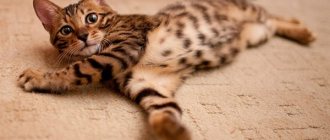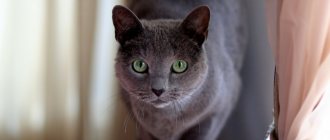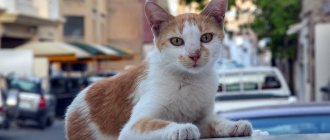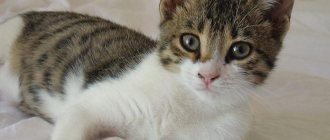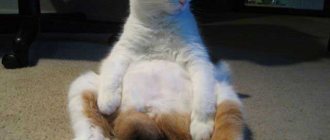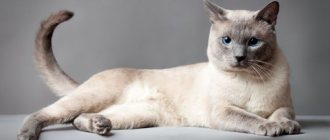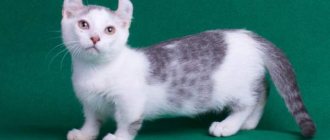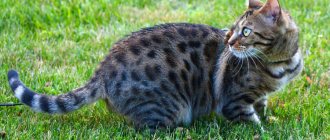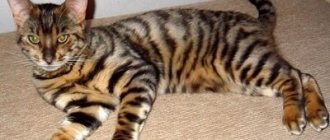The history of the appearance of Bengal cats
The story of the appearance of these wonderful creatures begins in 1961, when genetic biologist Jean Sugden went on a business trip to Southeast Asia, where she noticed beautiful and graceful wild cats with a very unusual color, which almost immediately won her heart. The young geneticist was extremely upset by the state of their population - the breed was on the verge of extinction due to poachers rampaging at that time. It was because of the uniqueness and beauty of the appearance of these cats that they were exterminated and their skins were sold for huge sums of money. Since Bengals were not much larger in size than an ordinary cat, small kittens were sold in markets, passing off as cute pets, which later brought a lot of problems to their owners, because Bengal cats are not suitable for living at home.
The wild Bengal cat lives in the forests of India, China, Indonesia, Thailand, Tibet and the Philippines
Having bought a Bengal cat kitten at the market, Jean took him home to the States. She named the cat Malaysia, and she began to get used to her new home. Albeit with distrust, but gradually the cat got used to it, settled down and did not show strong aggression towards its “roommates”. During her heat, she even became friends with Jean's house cat, resulting in the birth, to everyone's amazement, of a spotted hybrid cat in 1963. After this, Jean decided to get serious about creating a breed of cats that looked like wild Bengals, but had the character of domestic cats.
Unfortunately, due to the death of Jean's first husband, the research was interrupted and resumed only 15 years later. Jean, now Jean Mill, learned that the University of California, USA, was conducting comparative studies of the immunity of domestic and wild cats, during which interspecific crosses were carried out. Jean asked to be given several first-generation hybrids for further research, and received 9 females at her disposal. It was from this moment that Jean began to seriously pursue her dream and resumed her attempts to breed a domestic Bengal cat.
Jean spent a huge amount of time and effort, overcame many difficulties, and her efforts were rewarded: in 1982, a kitten appeared - a hybrid of a domestic Mau cat and a wild Bengal cat. It had a wonderful golden-orange color (later called glitter) with the characteristic sparkle and rosettes of the Bengal breed. After this, many more crossbreedings were carried out, wild Bengal cats were brought from India for experiments, and in 1991 Jean presented the ideal kitten with a gorgeous color and sweet character. In the same year, the standard for Bengal domestic cats was officially approved.
The brightness of the color of a Bengal cat depends on nutrition and care
Where does the Bengal breed come from?
In the forests of India along the banks of the Bengal River, leopard cats of the species Felis Bengalensis are found. They became the founders of the domestic Bengal breed. These predators are distinguished by their small size and secretive behavior. Since ancient times, wild Bengal leopards have been purchased from poachers by lovers of exotic animals. Until the predator was crossed with a domestic cat.
Leopard cats from India are the ancestors of domestic Bengals
It all started with the fact that in 1963, American Jean Sajen (a psychologist interested in genetic experiments and hybridization issues) accidentally crossed a wild leopard cat, purchased at a veterinary store, and a black domestic cat. The animals were placed in one cage just for company, and after a while the cat gave birth to offspring. Although zoologists deny the possibility of interspecific crossing, the unplanned experiment was a success. And the surviving female gave birth to new offspring - a black male and a spotted girl. The first one could not be saved, and the female subsequently gave birth to offspring from her father. The litter included a black cat and a leopard-print cat.
Jean Mill initiated the breeding of the Bengal cat breed
However, due to the death of her husband, Mrs. Sajen was forced to give the animals to a nursery, where the kittens contracted pneumonia and died. The researcher returned to experiments with crossing Asian leopards and domestic cats 14 years later, when she was already Mrs. Mill (by the name of her new husband). The woman began to collaborate with scientists at the University of California who were conducting research on panleukopenia (distemper) in cats. Jean Mill worked in the team of Dr. William Centerwall until 1982. During this time, the foundation for the Bengal breed was laid, although all males were born sterile. Crossing was carried out with brown shorthair cats. In 1983, the Bengal cat breed was registered with the International Organization TICA.
Since then, the history of the new species of the cat family has developed according to the following scenario:
- 1988 - founding of the International Community of Bengal Breed Connoisseurs TIBCS;
- 1991 - official recognition of the Bengal breed, opening of a champion class for representatives of the breed at exhibitions;
- 1997 - the appearance of French and American Bengals in Moscow, the founding of the Tsesarion club.
The breed standard has not yet been recognized, but has been allowed to participate in exhibitions under the WCF system since 1991.
Despite the love of breeders and ordinary people for such unusual cats with bright spotted colors, the Bengal breed is still considered rare, because new donors are not found as often as we would like.
Video: Bengal cat, lecture about the breed
Description of the Bengal cat breed
Bengal cats are beautiful and stately animals that combine the exotic appearance of a wild animal and the ability to become a loyal and gentle friend to their owner.
Appearance of Bengals
Cats have a very muscular, lean body - this heritage of their ancestors suggests that they can survive in wild, extreme conditions. The size of the Bengal is slightly larger than that of an ordinary domestic cat, and the males of this breed are larger than the females. Males can reach 32 cm at the withers and gain up to 6.8 kg, cats - about 28 cm and up to 5.4 kg. The paws of representatives of the breed are round, the tail is wide in diameter, but not long. The muzzle is wide, the neck is massive, muscular, the ears are medium in size, widely spaced on the head and have rounded tips. The eyes are also widely spaced, large, oval, most often golden or green in color. Intense blue eye color is very rare, particularly in Snow Bengals.
Silver bengals, their appearance reminiscent of irbis (snow leopards), are the rarest and most expensive
The fur of the Bengal cat is short, soft, thick and shiny. The standard color of Bengal cats is leopard or marbled with a black pattern. The hue is most often golden orange, gray or white.
Bengals range in color from leopard-like spotted to rosette and marbled.
According to the breed standard, the ideal Bengal cat has the following distinctive characteristics:
- shiny, soft, silky coat, short or medium length;
- muscular, stretched body;
- spotted or ringed tail (necessarily with a dark tip);
- the hind legs are longer than the front legs;
- proportional, long, thick neck;
- chubby cheeks, massive chin, wide nose;
- ears wide at the base, set high, with rounded tips;
- golden or green eyes.
Bengal cat personality
A Bengal cat is a very active, sweet, curious and, with proper upbringing, a very loyal creature. Mill achieved her goal, she brought out exactly what she wanted. The opinion that Bengals are aggressive is a prejudice of ignorant people. If you teach a cat from infancy to affection and treat it with care, it will definitely become your excellent friend. Bengals have very well developed hunting instincts, they are active and agile, so they should never be kept in an enclosure - there they can grow up shy and aggressive.
These cats very quickly get along with children and other pets. Because of their intelligence, Bengals understand that children are cubs, just like kittens, so if a child makes this breed uncomfortable, it will leave rather than defend itself. Bengals quickly become attached to people, but most often they choose one family member as their owner, and are simply loyal to the rest of the household.
Bengal cats are very playful and curious - they often retain such character traits until old age. Therefore, try to provide your pets with a variety of toys if you want things that fall into their field of vision - curtains, chests of drawers, small things - to remain safe and sound.
Unlike other domestic cats, Bengals love water very much: they can take a bath with you or swim alone, splash in the toilet and even “fish” in the aquarium - be careful
Bengals really love attention to their person and for this they will even commit a crime, for example, they will start stealing small things like hairpins, combs, and pens. Like dogs, cats of this breed absolutely love walks in the fresh air, so they can be walked on a leash or harness.
Video: appearance and character of Bengal cats
Features of the character and upbringing of Bengal cats
Mentally weighing the pros and cons of the breed, you should first of all understand that a Bengal kitten is like a child: everything is interesting to this nimble rascal, he strives to get into everything. Forget all your previous ideas about cats lounging all day long on a cozy lounger: the level of activity of your new friend will not allow him to sit still for long. With a high probability, the cat will follow you around the house, wanting to be involved in all the affairs of the family, and in response to being ignored, it will be seriously offended. Therefore, when purchasing a Bengal, plan to entertain him thoroughly.
How to raise this little mischief maker who can jump on you in the middle of the night, chasing imaginary prey? This process should begin as early as possible, because after eight months it will be much more difficult to rid the cat of unwanted habits. In addition, the pet will be nervous, which will certainly affect its life expectancy. Fortunately, Bengals are not only extremely smart, but also, along with other, no less exotic Abyssinian cats, they are quite easy to learn “decent manners” and train.
You will be surprised, but your pet can be taught to walk on its hind legs, roll over on command, fetch slippers, and so on. Not to mention potty training a Bengal. The pet grasps commands without much difficulty, just like the dog. Like a dog, he is ready to defend his personal territory, bring an abandoned toy to his owner, and even protect him from people, objects or household appliances that, in the animal’s opinion, are unfriendly.
Play is an important element in the development and education of a cat. She will help him express his predatory instincts safely for himself and the interior of the house. The main thing is to correctly stop possible aggressive actions of the baby. And, of course, the cat absolutely needs physical activity, without which the animal will wither away.
The Bengal cat has a bright character, in which the natural intelligence of a predator is harmoniously combined with the softness and playfulness of a domestic cat. The Bengal cat is well socialized, attached to the owner, and faithful to him, like a dog. She is sensitive to changes in the mood and atmosphere in the house, and also perfectly remembers words and intonation addressed to her. These cats love the company of people, they are quite talkative, affectionate and friendly, including other pets, including dogs, with whom the Bengal will happily make friends.
However, you should not squeeze this animal too much - the rare Bengal cat will be delighted with this.
“Five minutes of tenderness,” this is how Marina Brakstad the behavior of her pet, a Bengal named Felix.
“He will come, purr, cuddle up to me for five minutes, and then move away, he doesn’t really give into my hands, but at the same time he doesn’t go far, he’s always there,” she said.
Bengal cats also do not favor spontaneous communication with strangers: in order to make friends with house guests and begin to trust them, the animal will need time.
Basic criteria for choosing a kitten
When choosing a kitten, it is important to understand: a lot depends on the pedigree, but even champion show cats can give birth to quite ordinary kittens. When choosing a pet, the main thing is that it is healthy. Therefore, you should not buy a kitten before two months of age - it must have time to be nourished with mother’s milk and develop immunity.
When choosing a kitten, carefully examine its ears, nose and anus - they should be clean and free of discharge. A healthy kitten is agile and playful. It would be a good idea to inquire about the health of his parents.
Moving a kitten to a new home only when it reaches three months of age is a necessary condition for the success of its further development.
When choosing a kitten, it is worth keeping in mind that Bengals have three quality classes - “pet”, “breed” and “show”:
- "Show" - the most expensive, elite cats. They have an ideal pedigree, ideal appearance, parents with many titles. In addition, such Bengals have the most golden character; it is not a shame to show up at exhibitions with it. This class is very rare, not all breeders have it, therefore, if such a kitten is born, they try not to sell it and leave it in the nursery for further breeding and participation in exhibitions.
- “Breeding” - this class with ideal breed characteristics is mainly intended for producing offspring. Bengals of this class may not have a bright appearance, but their gene pool is stable, and in the future they will give birth to good kittens.
- “Pet” are Bengals for home keeping, pets, so to speak. They do not have a particularly bright, exhibition appearance; they may have a hidden defect that will only be noticed at exhibitions, but this does not make them any worse.
How to choose a Bengal kitten?
The Bengal pet is an intelligent and very loyal animal. This kitten will become a full member of your family, brighten up your everyday life and cheer you up even in the most difficult moments of your life. An unusually active and curious little Bengal with a beautiful bright leopard color will become a faithful friend to both children and adults. However, you need to remember that he requires a lot of attention and constantly needs communication. With the appropriate attitude, this pet always responds to its owners with complete reciprocity, bestowing them with its tenderness and love.
The choice of a Bengal kitten must be approached very responsibly: you cannot purchase such an unusual animal from random people, according to advertisements in the newspaper or on the market. Selling a purebred pet at too low a price is a common scam. Such a kitten cannot be cheap. Before buying, first of all, you need to decide on the class of the small Bengal, since its cost depends on this. There is the following gradation:
- pet class. The kittens have all the characteristics of the breed and have a pedigree, but due to small deviations in appearance from the official standard, they are not suitable for exhibitions and breeding work. Pet-class animals are the most suitable option for buyers who want to have a purebred kitten at home and spend relatively little money on purchasing a pet;
- Breeding class. The animals are ideal for breeding. Such cats have excellent pedigree, good health, and fully comply with the breed standard. Bengal kittens of this class are already much more expensive, the price depends on the region, season, color;
- show class. These are very expensive elite animals. Cats of this class participate in various exhibitions and have certain titles.
After you have decided on the class of the animal, you need to choose the gender of the future pet. It all depends on personal preferences: some people prefer to have cats, others prefer cats. The character of a Bengal kitten should not be identified with its gender. A boy, for example, can be very calm, while a girl can be overly active. Of course, a pet, regardless of class and gender, must be completely healthy.
If you are buying a Bengal kitten - either for yourself, or for breeding work and exhibitions - you must contact only special nurseries. Firstly, the purity of the breed is guaranteed, which is confirmed by relevant documents. Secondly, each nursery is responsible for the health of the kitten and must provide the buyer with all the necessary veterinary certificates about vaccinations, deworming and other preventive measures. Thirdly, in this establishment they always talk in detail about the characteristics and habits of the purchased kitten, and give very valuable advice on caring for a small Bengal.
Features of keeping a pet of the Bengal breed
Many people buy a Bengal kitten just because of its appearance and character, without thinking that it will be much more expensive to keep it than an ordinary cat.
Pet food
There is a lot of debate about how to properly feed a Bengal cat. Some believe that only natural products can be beneficial for a pet’s health, while others are inclined towards ready-made food. So far, even veterinarians do not know exactly who is right. Therefore, everything depends on the owner: if you are not ready to select meat, vegetables and other natural products, competently compiling a cat’s diet, then buy ready-made food. In this case, you should first study the reviews and make sure of the quality of the product.
Ready-made cat food
The food must be premium or super premium. The highest quality ones include:
- Hills;
- Royal Canin;
- Yam;
- Nutra Gold;
- Eagle Pack;
- Akana;
- Purina Pro Plan.
It is important not to mix different foods, since Bengals’ digestion is very sensitive and does not respond well to a change in diet.
If you have any doubts about nutrition, contact the breeders and ask what they fed. The right choice of quality food will save you from the problems of creating a daily balanced menu for your pet.
Natural products in the diet of cats
Kittens up to one month old feed on their mother's milk. Afterwards, you can start feeding them raw scraped meat, cottage cheese, diluted milk, and meat porridge. In the first two months, kittens need to be fed 4–6 times a day; after two months, you can reduce food intake to two to four times. By five months, it’s time to accustom kittens to an adult diet and feed them no more than twice a day.
Having made a choice in favor of natural food, you should include the following products in your cat’s diet:
- raw meat should make up 50–60% of the cat’s main diet, for example, beef, rabbit, turkey;
- dairy products such as fermented baked milk, cottage cheese, kefir with low fat content;
- raw or boiled vegetables;
- oatmeal (cooked in milk), buckwheat and rice with the addition of vegetables or meat - cereals should make up no more than 15% of the total diet.
Unlike other domestic cats, Bengals are reluctant to accept fish, so it is better to exclude it from the menu altogether, especially since this product is not very useful for the cat’s health and can cause diseases of the urinary system.
The role of a balanced, proper diet is very important if you decide to purchase a Bengal cat. She inherited a shortened intestine from her wild ancestors, and therefore her body is very sensitive, and improper nutrition can lead to undesirable consequences, including death.
Video: myths about cat food
Appearance care
Caring for the appearance of Bengals is not so difficult:
- There is no need to comb them: they have short hair, it sheds little, and you only need to go through it a couple of times with a metal comb.
- Considering that the Bengal cat most often loves water, bathing her becomes a pleasure for the owner. Like regular cats, they need to be bathed infrequently - 3-4 times a year is enough.
- But you should clean your ears of dust and wax regularly.
- From a young age, it is necessary to accustom your pet to a scratching post, because Bengal cats are very active and can damage furniture with overgrown claws.
- It is also important to take care of your teeth and gums so that plaque does not form on them, which contributes to the development of inflammatory diseases of the oral cavity. It is enough to brush your teeth a couple of times a month with a special toothbrush.
- Once every 3 months you need to carry out anthelmintic treatment.
A kitten's tray should not have high sides; it is best to leave the one the breeder had. An adult cat, on the contrary, needs to purchase a large tray with high and rounded sides. Bengals love cleanliness and carefully clean up after themselves, burying waste deep in the sand - in the absence of high sides, cleaning will be difficult.
History of the Bengal breed
The Bengal cat is a hybrid of a wild Asian leopard cat with a domestic one. In the middle of the last century, leopard cats were almost completely destroyed by poachers. American Jean Mill bought a female wild animal kitten in 1961 and began breeding experiments on crossing with ordinary domestic cats in the hope of saving the Asian leopard breed from extinction. The first results were not entirely successful; the kittens appeared, although similar to their wild ancestors, but were aggressive, some died or were unable to reproduce. Mill continued her work, which lasted for 20 years, resulting in the emergence of the most beautiful breed of Bengal cat, which retained the wild color of its ancestors and the affectionate habits of domestic cats.
The breed was officially registered only in 1991. By that time, the best qualities of many exotic, short-haired breeds, Persian, Egyptian Mau and Burmese cats were mixed into it. In 1997, the breed first appeared in Russia, but its distribution began only in 2005. Today in our country there are a large number of nurseries of this breed, the cost of purebred kittens is from 35 thousand rubles, premium class exhibition specimens cost from 100 thousand rubles. (inf. 2021)
Defects in appearance
The breed standard is very strict. There are even defects invisible to the eye that lead to the disqualification of an animal at an exhibition. The main defects in appearance are:
- small size, not suitable for the Bengal breed;
- presence of white spots;
- vertical stripes - “ribs” on the body;
- flattened chest;
- strabismus;
- number of fingers different from the norm;
- visible tail defects (for example, creases).
These shortcomings do not pose a threat to the life of the pet, but generally these Bengals no longer participate in reproduction and remain simply pets.
Diseases of the breed
Bengal cats are very resistant to diseases. Initially, they were susceptible only to diarrhea, but over time, more dangerous ailments began to develop - hypertrophic cardiomyopathy and flat chest syndrome in kittens. Allergies also began to appear very often.
To avoid health problems, carefully monitor your pet’s diet, take your cat for preventive examinations to the veterinarian at least once a year, properly vaccinate him, carry out antiparasitic therapy, and if your plans do not include breeding, then it is better to sterilize him.
Check twice, buy once
The price of a Bengal cat cannot be low. This is an axiom that allows you to be wary when you are offered to buy a kitten at a reduced price. There are two options here - either it’s a fake, or the kitten is sick. Walk past such advertisements and do not pay attention to them.
There are several kittens in a litter, and breeders usually offer to choose one of them. You should be wary if you are offered a certain animal, praising its beauty and character. There may be a situation of deception on the part of unscrupulous sellers, which may lead to you purchasing a counterfeit product.
Basically, the breed is important for people who dream of receiving awards and medals at various exhibitions. The organizers and judges of such events will quickly and easily distinguish a purebred Bengal cat from a mongrel one. It would be very unpleasant to find yourself in such a situation. Be careful, choose wisely, and then your kitten will turn into a beautiful, stately cat worthy of all awards.
Breeding Bengal cats
If you decide to start breeding Bengal cats for the first time, it is advisable to contact experienced breeders. They can explain which representatives would be best suited to breed your cat and can provide guidance on the ideal candidate. You should not try to breed your cats with regular house cats if you want small Bengals. This will result in hybrids and they may not look like Bengals, which will likely disappoint their owners.
Bengals can only be bred with representatives of the same breed
When choosing a Bengal cat for mating, you need to look not only at its health and affectionate character, but also at its appearance, namely at the typical signs of the breed: if it has pale spots or, for example, paws that are shorter than normal, then such a cat should not be taken for mating. worth it, since his genes are no longer ideal, and his offspring will move further and further from the standards.
It is imperative to check the kitten’s pedigree up to three generations and find out whether all vaccinations are up to date. It is advisable that the kitten has ready-made tests for the presence of infectious diseases.
Mating
Bengal cats mature at approximately 8–9 months of age. Usually at this time they become nervous, unbearably capricious, and demand attention. The first mating is best done with a female who has already given birth to offspring, then you can take the cat to mating at least once or twice a week. A Bengal cat can give birth twice a year.
Cats mature more slowly, but they can be mated for the first time between 5 and 9 months. Estrus can last from three days to two weeks, and sexual inactivity can last about four months.
Pregnancy lasts about nine weeks, its symptoms differ little from other types of pregnancy. In the third week, the cat begins to vomit, she becomes lethargic and quiet. By the middle of the term, the Bengal will begin to gain weight, and by the seventh week, she will begin to look for a place for a nest.
Try to make your pet a birthing house yourself: find a box for this, prepare clean and dry rags, come up with a heating system so that the future offspring do not freeze. A week to a week and a half before giving birth, it is advisable to tame the cat to the nest so that she feels comfortable there with the kittens.
Bengal cats are not particularly fertile: there is a maximum of four kittens in one litter.
If you decide to start breeding Bengals, first consult with experienced breeders, they will advise how to choose the best candidate for breeding. Your pet needs to look for a partner not only in a kind, sweet and affectionate cat, but also in an ideal representative of Bengal cats, healthy, vaccinated, without obvious flaws in appearance and with a good pedigree.
Mating always takes place on the cat's territory - this option brings less anxiety to the partners. The cat is usually left with the cat for several days so that they have time to mate several times. A successful mating is indicated by a sharp change in the cat’s behavior. She becomes calmer and stops screaming, but it is possible to say with certainty that the female is pregnant only after the results of an ultrasound, which is carried out two weeks after mating. If the first mating was unsuccessful, do not rush to get upset, this procedure can always be repeated.
If you are the owner of a cat and breed your pet with a cat of other owners, then the kittens belong to you, but the other party will have to give a set amount of money or one kitten from the litter
Breeding
Estrus
Estrus begins at 7-9 months (4-6 times a year). At the same time, males mature. There is no bloody discharge. You can understand the onset of estrus only by behavior.
Mating
Mating is carried out only for pets that meet the standards. In other cases, breeders prescribe mandatory sterilization or castration as conditions of purchase. Mating occurs on the territory of the male (2-4 days). On day 14 you can do an ultrasound and check the results.
Pregnancy
Gestation period is 65-67 days . The diet should be complete. The cat's appetite increases significantly. By the end of the term, it is necessary to take care of the place of birth and invite a veterinarian/breeder.
Childbirth
The process lasts up to 6 hours. If the cat refuses the kittens, the obstetrician will have to take over the function of clearing mucus from the respiratory tract and eyes. Next, they throw out the afterbirth and change the diapers, leaving the cat alone with the offspring.
Castration and sterilization
If you do not plan to breed Bengal kittens, then the best option would be to spay or neuter the animal. There is little scientific evidence about the best age to sterilize animals. There is early sterilization, when the kitten has not yet reached puberty. Its advantage is that he has not yet experienced the severe psychological and physical consequences of the need for mating. More standard sterilization is carried out when the animal has already reached sexual maturity (starting at 7–8 months).
After the operation, the Bengal cat requires good care. In the first twelve hours you should not leave your pet; it is best to place it in a warm, soft and clean place. Under no circumstances should you feed the animal, but after six hours you can give water. It is important that there is a clean tray nearby without filler.
After surgery, you need to carefully monitor your pet’s diet, as his activity decreases, he will begin to move less, and if you continue to feed him as abundantly as before, this will lead to obesity.
Pros and cons of the Bengal breed
| pros | Minuses |
| Sharp mind, endurance | Excessive activity and noise can ruin many things in the house |
| If raised correctly they are very friendly | If you don't educate or tame, he will grow up wild and aggressive. |
| Practically do not shed and do not cause allergies in owners | They love to mark their territory |
| Easy to train | Changeable mood |
| Gets along well with people and other animals at home | Very freedom-loving - some representatives of the breed do not like to be picked up |
| They love water | A very expensive breed. Expensive kittens + expensive maintenance, food |
| Very beautiful, have an unusual color | The breed is rare, real Bengals can only be found in official kennels, which are located in the largest cities |
| Soft, silky wool |
Reviews from Bengal cat owners
Advantages: affectionate, smart, a companion dog, not a cat, I don’t shed.
Disadvantages: excessive mischief.
Let me start with the fact that our cat died in the summer, we also have a dog at home, but it turned out that life is not the same without a cat. I sat down to read, they dissuaded me from getting a fold dog again (all the breed-related diseases that could have been present in our deceased cat), and I came across an advertisement for the sale of kittens of the Bengal breed. My husband appreciated it, but was shocked when he saw the price tag, looked at me, sighed heavily and agreed. I liked the reviews, but apparently my foggy mind, fascinated by the beauty of this breed, missed about Activity))) or it just didn’t occur to me how active they are))) in general, after a month of searching, I galloped home with the kitten in hands (the cat was named Zaharik), my joy knew no bounds, which was not at all shared by the dog, who immediately received a claw in the eye from the new tenant (the eye was repaired). Well, actually about the cat - unlike Scottish Folds, who sleep 90% of their lives, this spotted monster spends 90% of its life in a state of alertness, and he believes that all households should be invigorated, so early in the morning, when the cat begins to move around the apartment with a very mysterious expression on its face, its gaze expresses a thought, and the thought, I’ll tell you, is always the same: what to do to such a mischief. Favorite entertainment - a sponge for washing dishes - there is no better toy, magnets from the refrigerator are also a super toy, you can pull them off in two ways: 1. jumping from the table into the door 2. jumping from the window sill into it, then flowing down it with a magnet in the paws. There is nothing cooler than breaking all the blooming orchids and then running around the apartment from a slipper. The stopper for the bathtub and for the sink in the kitchen is hidden in such a way that sometimes we ourselves don’t remember where we put it. Digging into flower pots and nibbling on them is a lot of fun. Water... oooh, yeah, that's a different story, our cat was definitely a diver in a past life)))) bowls of water are always upside down (I've already replaced them with trays with bowls, because the laminate will soon become a house), we definitely need to drink from under tap. In general, they can do mischief just anywhere, it won’t even occur to you, but he’s already done it))) In general, the breed is very human-oriented, they are very capricious, Zakhar doesn’t like it when my dog sits on hands, makes slits in his eyes and rushes to bite me (he is jealous with terrible force), they should love only him alone, when I’m at home, he follows me around, if I’m cooking something, he immediately climbs on the table if I’m in the shower , then he sits on the bathtub and watches. I thought I had a dog as a companion, never mind, Bengals are just a shadow of a person. They are very affectionate, ours knows how to kiss, in the morning I scoop him up and he pokes his pug on my lips. The ideal option to get this breed is if someone does not work at home or there are schoolchildren... because bengs do not like to sit alone, they need company. Ours staged a whole protest when I returned from sick leave to work. We thought that castration would reduce the activity somewhat, never mind, only the look has changed - it’s not so crazy))) In general, we are all waiting and hoping that he will grow up, Zakhar recently turned 1 year old, about how they carry toys in their teeth , - this is a separate story, my husband and I have developed a shoulder girdle in such a way, in the evenings the only entertainment is throwing a toy to the cat)))) Oh, and we had a story yesterday: we accidentally closed the door to the toilet, the cat yelled (well, we somehow didn’t We really paid attention, this happens to him), then we hear something scratching, I go into the bedroom, an oil painting - a cat shit on the windowsill and covered the poop with soil from a pot with a flower, the top of the head was cleaned up) they neighed, cleaned it up, and let the cat go to the toilet. They are such fools)) But, despite all of the above, we love him very much.
EGavrilova
https://otzovik.com/review_942312.html
+ Inquisitive, not afraid of water, very clean, very, very beautiful, becomes attached to the owner.
- Wild character, expensive, sometimes bites, scratches painfully, bites hard, talks very loudly.
Hello! I want to share my opinion about the Bengal breed. Of course, this is a very beautiful color. But I would like to tell you my story for those who are planning to buy a cat for themselves. Keep in mind that he is your master, unlike other breeds, he has increased activity. Requires 100% attention. Everything in the apartment turns into toys, flowers are eaten, vases are broken, curtains are torn off, and this despite the fact that he has a cat town and two high scratching posts. But that’s not all)) my cat has aggression, he can attack for no reason and dig in with sharp fangs. On the other hand, when he is in a good mood, he allows himself to be petted. The tray is a different story. He likes the filler silica gel. And he needs to change it regularly, every 3-4 days. Otherwise it might make a mess. DO NOT get a cat if you are constantly away from home!!! Increased activity occurs at night. He sleeps for three hours at night, the rest of the time in search of adventure. Suitable for those who have active children.
BengaliBucks
https://nashemnenie.com/zhivotnye/18191-bengalskaya-koshka.html
Not the best choice if you value more than just looks
+ Beautiful, inquisitive, no aggression, silk coat, practically no tangles, spectacular
- Absolutely does not learn from his mistakes, is expensive, very loud and almost constantly yells, wayward
I got a Bengal cat a year ago. I took it from the nursery, of course, for money. The first impression is that she is very sweet and beautiful. The wool is smooth and pleasant to the touch. Several months have passed. The cat has grown a little. I wouldn't say that THIS looks like a real cat at all. Attention to the owner - 0. Almost does not purr, she did not come to caress or lie down. She fed normally, Royal Canin. She didn’t even caress me for food. He climbs on the table all the time, stealing food in front of his eyes. He doesn’t understand the word “no” at all. The expression in the eyes is always somehow stubborn and absent. She's really not afraid of water, she loved playing with it. Sometimes it’s funny to watch, but you want a pet, a friend, and this is just a new level of plush toy. The tray is a separate story. It scatters all the filler, and doesn’t even bury the dirt; rather, it scatters it along with the filler across the floor. So, if you like cleanliness, forget about this breed. I heard that they all behave like this. Overall there was quite a lot of litter. She picked cardboard from boxes and tore bags. Then the heat started. It came just in time for spring. It was something with something. She screamed incessantly, loudly and gutturally. All the time she stood doggy style, exposing herself. I had cats before her, and I saw them with my friends, but there was no such horror. And one fine day I was sleeping, this creature just came, lay down on me and pissed on the blanket along with me. I want to say right away that no one beat the cat, didn’t yell at her, she paid more or less attention, and didn’t give her any countersex. So the motives for this action are completely unclear to me. It would be fine to just piss on the bed or the floor. I give it 2 stars for appearance. I don't recommend starting it. She sterilized it and gave it to a friend in the summer, for whom the main thing is to show off with beautiful photos of the cat; she doesn’t need affection and love. Ordinary mongrel cats are much smarter and more affectionate!! It’s better to take a friend from the shelter for free who will love you.
Perfection
https://nashemnenie.com/zhivotnye/18191-bengalskaya-koshka.html
